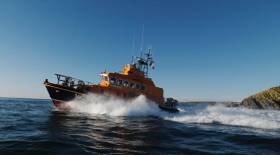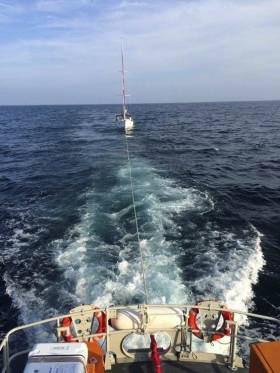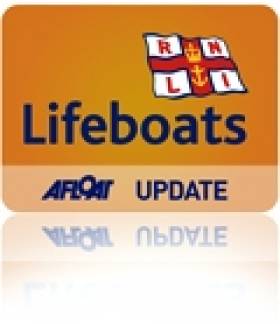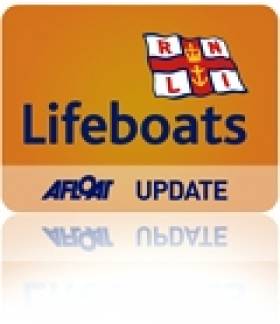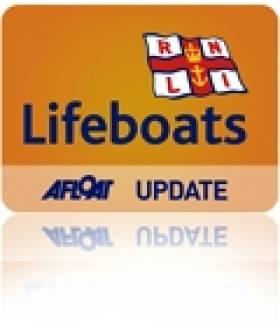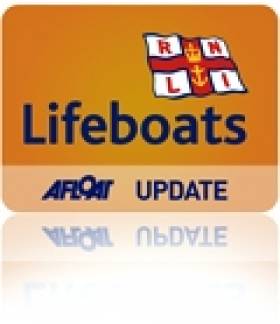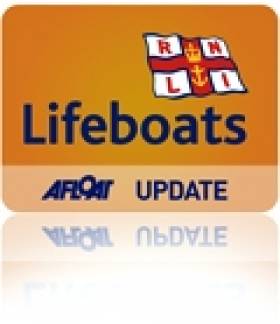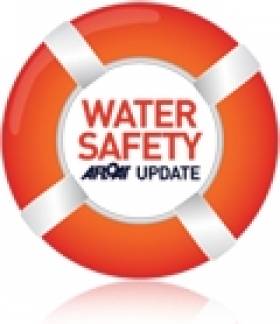Displaying items by tag: Ballycotton
Ballycotton Lifeboat Rescues Swimmer In Difficulty
#RNLI - Ballycotton RNLI was launched around 2.30pm yesterday afternoon (Tuesday 12 July) to aid a man who had got into difficulty while swimming in East Cork's Ballyandreen Bay and called for help.
A member of the public heard the man's call and immediately alerted Valentia Coast Guard, who tasked Ballycotton's volunteer crew to launch both their all-weather and inshore lifeboats.
The inshore lifeboat was first to arrive on scene and the crew on board recovered the casualty from the water before transferring him to the all-weather lifeboat, where he was medically assessed, administered first aid and given oxygen.
The Irish Coast Guard's Waterford-based helicopter Rescue 117 was also tasked and arrived on scene around 3pm to airlift the casualty to Cork University Hospital, where he is said to be in a stable condition.
Speaking following the callout, Ballycotton RNLI coxswain Eolan Walsh said: "We would like to commend the member of the public who raised the alarm today as well as the immediate first aid action of the volunteer crew.
"Their quick-thinking and actions ensured that there was a positive outcome today for this casualty. We would also like to wish him a speedy recovery."
Ballycotton Lifeboat Lauches To Yacht In Difficulty
#RNLI - Ballycotton RNLI was launched around 6pm yesterday (Sunday 5 June) to a yacht in difficulty 10 miles off the East Cork coastal village.
The 50ft yacht, carrying four people on board, got into difficulty when its propeller became wrapped in fishing nets 300 miles off the south coast of Ireland some three days previously.
Due to the calm, mild conditions, the yacht was unable to sail any further and had to call for assistance.
When the volunteer lifeboat crew with Ballycotton RNLI arrived at the scene, they secured the vessel, ensuring all members of the yacht were safe, before taking the yacht under tow to Crosshaven Harbour.
Speaking following the callout, Ballycotton lifeboat mechanic Peter O'Shea said: “Although the yacht was in no immediate danger, its crew kept in regular contact with the coastguard and when they came close enough to land they requested assistance and the Ballycotton RNLI was launched.
"By keeping in regular contact the outcome was positive for all involved and it ended well.”
Ballycotton Lifeboat Rescues Kitesurfer In Difficulty
#RNLI - Ballycotton RNLI rescued a kitesurfer who got into difficulty on Ballycotton Bay on Monday afternoon (2 November).
The volunteer crew were requested to launch both their all-weather and inshore lifeboats by the Irish Coast Guard at 12.30pm and go to the assistance of a kitesurfer who was in difficulty but in no immediate danger in Ballycotton Bay on Co Cork.
The alarm was raised by a member of the public who spotted the kitesurfer struggling due to a lack of wind. Weather conditions at the time were described as overcast and calm.
Once on scene, the lifeboat crew assessed the situation before bringing the kitesurfer on board the inshore lifeboat and safely back to shore.
Speaking following the callout, Ballycotton RNLI coxswain Eolan Walsh said: "We would like to commend the member of the public who raised the alarm today. Their quick thinking ensured the lifeboats were launched and that there was a positive outcome."
Lough Ree Lifeboat Tows Cruiser Off Rocks
#RNLI - Volunteers from Lough Ree RNLI were called to assist two people last Wednesday afternoon (30 September) after their motor cruiser ran aground on a shoal near Green Island on Lough Ree.
The crew was requested to launch their inshore lifeboat The Eric Rowse at 12.30pm following a report that the 42ft cruiser was aground west of Killinure Point.
Launching to the scene within minutes, the lifeboat crew found that no one was in any immediate danger and there was no damage to the boat.
Weather conditions at the time were described as bright with a Force 2 south-easterly gentle breeze and calm waters.
The crew set up a towline and moved the vessel into safe waters. Under their own power, the couple then proceeded towards Athlone.
Speaking following the rescue, lifeboat helm Tom Bradbury said: "There are a lot of shallow areas and rocky shoals on Lough Ree which can catch even the most experienced of sailors out.
"We would always encourage people taking to the lake to locate the next navigation marker every time you pass one as good practice and if you get into difficulty to request help as this couple sensibly did on this occasion."
Later that same afternoon, Ballycotton RNLI was launched to a kitesurfer who got into difficulty near Ballycotton Lighthouse.
The all-weather lifeboat and its volunteer crew was launched at 2.44pm in choppy seas with swells of up to two metres following a call from a nearby observer who spotted the kitesurfer in difficulty.
The kitesurfer was blown onto nearby rocks where they waited for assistance from the Ballycotton RNLI.
Speaking following the callout, coxswain Eolan Walsh said: "The kite surfer was lucky that a nearby observer spotted them in difficulty. We would always encourage anyone going on the water to carry a means of communication in case of emergency."
#RNLI - Ballycotton is in the news again, this time in a feature on RTÉ One's Nationwide next Wednesday 6 August exploring the East Cork town's efforts to bring home their former lifeboat Mary Stanford.
As previously reported on Afloat.ie, the famous lifeboat was saved from being scuttled earlier this year and returned to her spiritual home in Ballycotton in late April.
The Mary Stanford served at Ballycotton for 29 years from 1930 to 1959 and took part in 41 rescues in that time, saving a total of 122 lives.
She was also involved in of the most famous rescues in RNLI history, which took place in February 1936 when she responded to a distress signal from the Daunt Rock Lightship which broke its mooring in a storm.
After a 63-hour mission, the Mary Stanford rescued all eight crew of the lightship and returned to Ballycotton safely. The crew all received RNLI Gold medals.
Unfortunately the Mary Stanford lay rotting in the water at Grand Canal Dock in Dublin after a failed attempt to maintain the boat.
But earlier this year, after local fundraising in Ballycotton, brothers Brendan and Colm Sliney and Colm's son Aidan made the trip to Dublin to bring the vessel back home.
They hired a crane to take the boat from the water and place her on a truck which made the journey to Ballycotton in two stages.
"We just had a few inches to spare going through the Dublin Port tunnel but we got through," recalls Colm Sliney after a heart-in-mouth journey down the motorway to Cork.
In April the team re-grouped to place the Mary Stanford onto a specially built plinth on the cliff walk above Ballycotton, and there were some heart-stopping moments during this mission, too.
The community in Ballycotton now plans to restore the exterior of the lifeboat to her former glory.
The Mary Stanford item will feature on Nationwide on RTÉ One next Wednesday 6 August at 7pm and afterwards on the RTÉ Player.
Ballycotton Lifeboat Rescues Four Teenage Canoeists
#RNLI - Ballycotton RNLI has rescued four teenagers who got into difficulty yesterday evening (Thursday 31 July) when out on a canoeing venture.
The volunteer crew was alerted shortly after 8pm and requested to go to the aid of four canoeists who were sheltering from a southerly wind at Ballycotton Lighthouse.
The all-weather lifeboat under coxswain Eolan Walsh launched at 8.15pm and made its way to the scene approximately a mile from shore.
Conditions at the time were challenging: well as a Force Four wind, which was at times reaching Force Five, there was also a one to two metre sea swell.
On arrival, the Ballycotton crew proceeded to take three canoeists on board the lifeboat. A fourth teenager escorted by the lifeboat managed to make their way safely to shore at Ballycotton Harbour.
Speaking following the callout, Ballycotton RNLI lifeboat operations manager John Tatton said: "The group made the wise decision this evening to call the lifeboat for help once they got into difficulty.
"The four, all of whom were wearing lifejackets had been out canoeing for a number of hours and got caught out by the weather as it deteriorated. We were delighted to assist and glad that all have been returned safe and well to Ballycotton tonight."
#rnli – Lifeboat crew at Ballycotton RNLI launched this afternoon (Saturday 26 July 2014) after the alarm was raised by a local ferry that a yacht with two people onboard had capsized 300 metres from Ballycotton Lighthouse off the Cork coast.
The lifeboat was launched at 4.18pm this afternoon and proceeded the short distance to the scene. On arrival the lifeboat crew saw two men sitting on the upturned hull of a small yacht that had capsized. They were both out of the water and not in immediate danger.
The Ballycotton RNLI all weather lifeboat came alongside the two men and recovered them aboard the lifeboat. Their capsized yacht was towed back to Ballycotton by the lifeboat. Conditions at the time were force 2 with a strong north westerly breeze.
Commenting on the callout Ballycotton RNLI Coxswain Eolan Walsh said; 'Thanks to the vigilance of the Yassy, a local passenger ferry, the alarm was raised quickly. With a capsize things can change from bad to worse depending on weather and the condition of the casualties. Thankfully both men were fine after the incident and did not need any medical assistance.'
#RNLI - The family of late musician Rory Gallagher have generously donated a replica Fender Stratocaster guitar, along with his original Oberheimer warm-up amplifier and stencilled flight case, to raise funds for Ballycotton RNLI.
The items will be auctioned later this month in aid of the Cork lifeboat station, whose lifeboat crew save lives at sea all year round.
The California-made Oberheim studio amp (serial 003), which was purchased by the guitarist in the mid 1970s, is extremely rare and remains in good working order.
These items will be offered for bidding as part of Whyte's Pop & Rock Memorabilia auction on Saturday 31 May from 4pm-6pm.
Viewing will be at Whyte’s galleries in Molesworth Street on Thursday 29 and Friday 30 May from 10am-5pm and Saturday 31 May from 9am-noon. Whyte’s have generously agreed to waive their commission so that all proceeds will go to the RNLI.
Dónal Gallagher, brother of the late blues-rock musician, said: "Rory would visit Ballycotton, where he was inspired to write material. This part of the country was very special to him and our family is delighted to be able to do this for Ballycotton RNLI.
"The volunteer lifeboat crew based there launches their lifeboat in all weathers and to all types of emergencies, saving lives at sea and helping those in trouble.
"I hope people who have a love of Rory’s music and are interested in the auction will take pleasure in knowing that in purchasing this incredible guitar and Rory’s own amp and flight case, that they are helping a great charity."
Speaking on Gallagher family’s kind donation to the charity, chair of the Ballycotton RNLI fundraising branch, Fiona Flynn, said: "We are extremely honoured by the Gallagher family’s kind donation... Rory Gallagher is one of the most respected and talented musicians ever to come out of Ireland and we are delighted that his family have chosen Ballycotton lifeboat station to benefit from this special auction."
Last year Ballycotton RNLI lifeboat launched 28 times and rescued 10 people. The majority of lifeboat crews are volunteers who undergo rigorous training to deal with every type of emergency at sea.
Ballycotton Lifeboat In Search for Missing Person off East Cork
#RNLI – The emergency services were alerted shortly before 5pm on Saturday afternoon, 10 August, that an elderly person might be missing at Garryvoe Beach. The Ballycotton RNLI lifeboat was asked to be on standby while the area was searched.
At 5:10pm the RNLI lifeboat crew pagers in Ballycotton were activated and the Ballycotton lifeboat was requested to launch to help in the search. Also requested to join in the search were the Ballycotton Coast Guard unit and the Waterford based Coast Guard helicopter, Rescue 117.
At 5:15pm the RNLI lifeboat boarding boat dropped the all weather lifeboat crew aboard the Austin Lidbury. The boarding boat then proceeded across Ballycotton Bay to carry out a search of the water close to the shore at Garryvoe. The all weather RNLI lifeboat launched and carried out a search of the deeper water in Ballycotton Bay.
At 6:35pm it was reported that the elderly person was safe and well and the search was called off.
Rosslare RNLI Praises Emergency Caller Despite False Alarm
#WaterSafety - Rosslare RNLI has given credit to the quick-thinking member of the public who raised the alarm over what they believed to be a swimmer in difficulty - even though the call-out turned out to be a false alarm.
Lifeboats from Rosslare Harbour and Wexford RNLI were involved in the sea search on Friday evening (19 July) after a swimmer was reported to be in difficulty off Curracloe beach in Co Wexford.
The Irish Coast Guard helicopter Rescue 117 and two local fishing vessels were also involved in the search, which was stood down after an hour and 45 minutes upon coastguard request as no one was reported missing.
Speaking after the call-out, Rosslare RNLI deputy launching authority Dave Maloney said: "The member of the public who raised the alarm this evening deserves credit for doing so."
He added: "We would always encourage the public to alert the emergency services if they see anyone they believe to be in trouble or any signs of danger."
The message is particularly important in a fortnight that has seen a shocking 10 drownings around the island of Ireland - resulting in a big rise in emergency call-outs over the 2012 mid-summer period.
Elsewhere on the same day, the Ballycotton RNLI lifeboat was requested to help search the water off Ballinamona Strand in Ballycotton Bay, Co Cork, for a missing five-year-old girl.
The little girl was playing on the strand when her family lost sight of her. Emergency services were alerted and a search of the area commenced, but thankfully a short while later the little girl was located safe and well.
In other water safety news, the Irish Coast Guard has issued a public appeal for help locating a training mannequin that was lost in Galway Bay during an exercise off Blackhead in North Clare last week.
The Connacht Tribune reports that five coastguard mannequins were placed in the water to acts as people who jumped overboard from a ship fire - but only four were recovered afterwards.


























